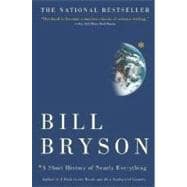
Note: Supplemental materials are not guaranteed with Rental or Used book purchases.
Purchase Benefits
What is included with this book?
| Acknowledgments | p. vii |
| Introduction | p. 1 |
| Lost in the Cosmos | p. 7 |
| How to Build a Universe | p. 9 |
| Welcome to the Solar System | p. 19 |
| The Reverend Evans's Universe | p. 29 |
| The Size of the Earth | p. 41 |
| The Measure of Things | p. 43 |
| The Stone-Breakers | p. 63 |
| Science Red in Tooth and Claw | p. 79 |
| Elemental Matters | p. 97 |
| A New Age Dawns | p. 113 |
| Einstein's Universe | p. 115 |
| The Mighty Atom | p. 133 |
| Getting the Lead Out | p. 149 |
| Muster Mark's Quarks | p. 161 |
| The Earth Moves | p. 173 |
| Dangerous Planet | p. 187 |
| Bang! | p. 189 |
| The Fire Below | p. 207 |
| Dangerous Beauty | p. 224 |
| Life Itself | p. 237 |
| Lonely Planet | p. 239 |
| Into the Troposphere | p. 255 |
| The Bounding Main | p. 270 |
| The Rise of Life | p. 287 |
| Small World | p. 302 |
| Life Goes On | p. 321 |
| Good-bye to All That | p. 335 |
| The Richness of Being | p. 350 |
| Cells | p. 371 |
| Darwin's Singular Notion | p. 381 |
| The Stuff of Life | p. 397 |
| The Road to us | p. 417 |
| Ice Time | p. 419 |
| The Mysterious Biped | p. 434 |
| The Restless Ape | p. 453 |
| Good-bye | p. 469 |
| Notes | p. 479 |
| Bibliography | p. 517 |
| Index | p. 529 |
| Table of Contents provided by Rittenhouse. All Rights Reserved. |
The New copy of this book will include any supplemental materials advertised. Please check the title of the book to determine if it should include any access cards, study guides, lab manuals, CDs, etc.
The Used, Rental and eBook copies of this book are not guaranteed to include any supplemental materials. Typically, only the book itself is included. This is true even if the title states it includes any access cards, study guides, lab manuals, CDs, etc.
Excerpted from A Really Short History of Nearly Everything by Bill Bryson
All rights reserved by the original copyright owners. Excerpts are provided for display purposes only and may not be reproduced, reprinted or distributed without the written permission of the publisher.